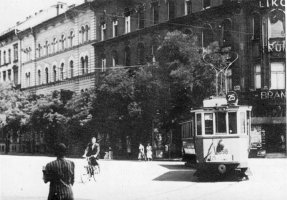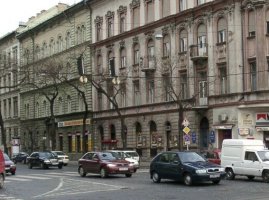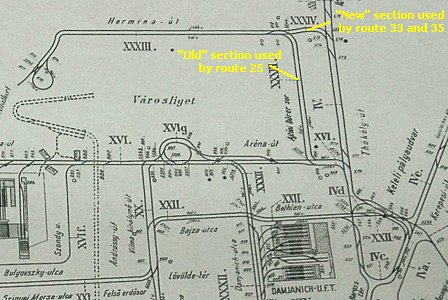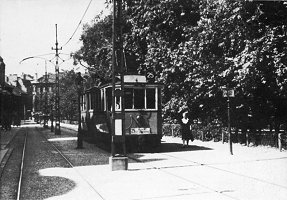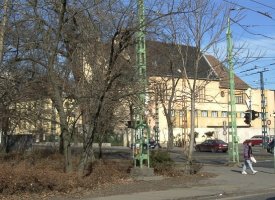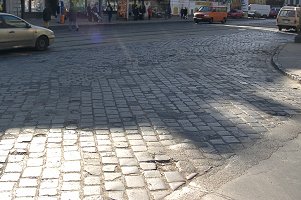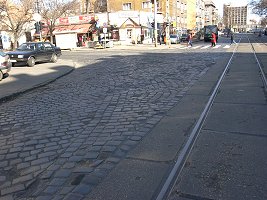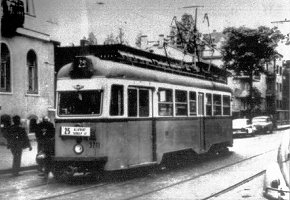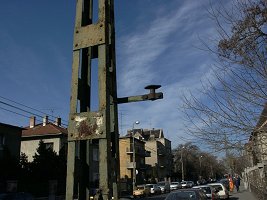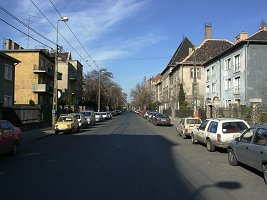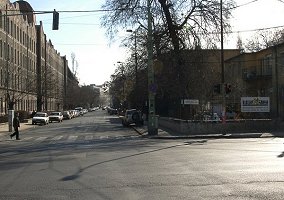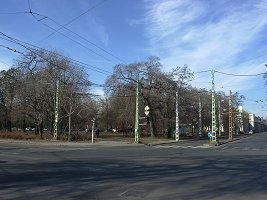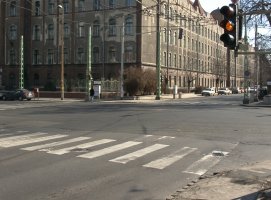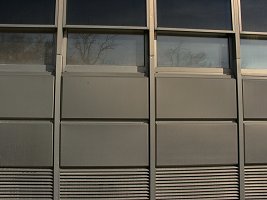budapest
other hungarian
close-up
lost rails
other countries
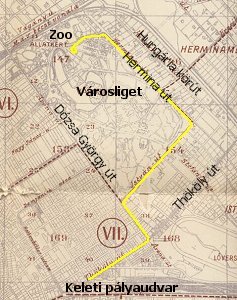 The
once existing tram route 25 is not really well-known, although I think
it would deserve more attention, because of the vicinity where it ran:
this line connected the Rákóczi út "public transportation axle"
of Budapest to the city park Városliget, a popular resting place
featuring amusement parks, a public bath (Széchenyi Fürdő), the
Budapest Zoo (Állatkert), the Budapest Grand Circus (Fővárosi
Nagycirkusz), and also the site of the Milleneum World Exhibition
in 1896. Later it also housed Hungexpo, the Budapest Exposition Center.
The
once existing tram route 25 is not really well-known, although I think
it would deserve more attention, because of the vicinity where it ran:
this line connected the Rákóczi út "public transportation axle"
of Budapest to the city park Városliget, a popular resting place
featuring amusement parks, a public bath (Széchenyi Fürdő), the
Budapest Zoo (Állatkert), the Budapest Grand Circus (Fővárosi
Nagycirkusz), and also the site of the Milleneum World Exhibition
in 1896. Later it also housed Hungexpo, the Budapest Exposition Center.
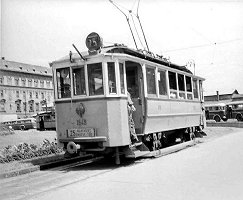 To
cut a long story short, this was a place with unusually high traffic on
weekends and holidays. In the middle of 19th century the need for public
transportation was satisfied by omnibuses, and later the horse trams of
BKVT. In 1896 the Milleneum Underground Line was inaugurated, with its
outer terminus located near Széchenyi Fürdő and the Zoo. Next
year BKVT extended its Thököly út tram line to the eastern corner
of Városliget. This section was extended further into Városliget
a few months later with the tracks circumventing the park and approaching
Széchenyi Fürdő from north.
To
cut a long story short, this was a place with unusually high traffic on
weekends and holidays. In the middle of 19th century the need for public
transportation was satisfied by omnibuses, and later the horse trams of
BKVT. In 1896 the Milleneum Underground Line was inaugurated, with its
outer terminus located near Széchenyi Fürdő and the Zoo. Next
year BKVT extended its Thököly út tram line to the eastern corner
of Városliget. This section was extended further into Városliget
a few months later with the tracks circumventing the park and approaching
Széchenyi Fürdő from north.
This route ran the following path from Keleti pályaudvar (railway station) - using current names to make things easier: Thököly út - Dózsa György út - Ajtósi Dürer sor - Hermina út - Állatkerti körút. It had a stub terminus near the terminus of the underground line, which was located on the surface. An interesting thing: the company has also built a one-track tie line on Hermina út between Ajtósi Dürer sor and Thököly út, but it wasn't used by normal traffic.
Various services used this route:
5: Óbuda - Lajos utca - Frankel Leó utca - Margit híd - Nyugati
pályaudvar - Small Boulevard - Kálvin tér - Üllői út - Nagyvárad tér
- Orczy út - Fiumei út - Keleti pályaudvar - Thököly út - Dózsa György
út - Ajtósi Dürer fasor - Hermina út - Zoo. This must have been quite
a ride!
19: Március 15. tér - Duna embankments - Fővám tér - Small Boulevard -
Rákóczi út - Keleti pályaudvar - Thököly út - Dózsa György út - Ajtósi
Dürer fasor - Hermina út - Zoo
Of course these were just the routes that used the same route that later
became route 25: there were various other tram services by BKVT and BVVV
running at the south-west side of Városliget.
In 1911 a turning loop was built instead of the old stub. BKVT also reorganized
its routes:
5: cut back to Zsigmond tér on its other end
17: a big circle-style line, similar to the former route 19, only that
this one went over to Buda over Erzsébet
híd, on Attila út and Krisztina körút to Déli pályaudvar and then
came back over Margit körút, Margit híd and the Small Boulevard
27: Közvágóhíd - Soroksári út - Boráros tér - Lónyay utca - Kálvin tér
- Small Boulevard - Rákóczi út - Keleti pályaudvar - Thököly út - Dózsa
György út - Ajtósi Dürer fasor - Hermina út - Zoo
37: Kőbánya - Kőbányai út - Orczy tér - Fiumei út - Keleti pályaudvar
- Thököly út - Dózsa György út - Ajtósi Dürer fasor - Hermina út - Zoo
In the BSzKRt era
the tram network was reorganized again, and some of the services disappeared,
while others were launched. This is when route 25 was born:
25: Hermina út - Ajtósi Dürer sor - Dózsa György út - Thököly
út - Keleti pályaudvar - Fiumei út - Orczy út - Haller utca - Soroksári
út - Közvágóhíd
Another "classic" route introduced was route 44:
44: Szépilona - Budakeszi út - Krisztina körút - Attila út - Döbrentei
tér - Erzsébet híd - Rákóczi
út - Keleti pályaudvar - Thököly út - Dózsa György út - Ajtósi Dürer fasor
- Hermina út - Zoo
On the picture above you can see a tram on route 25 turning from Dózsa
György út onto Thököly út.
As you can make out on the track scheme (which was drawn
in 1933) above, by this time they built out two normal tracks in Hermina
út between Ajtósi Dürer sor and Thököly út, so
the Zoo terminus could have been approached from two directions. This
new two-track path in Hermina út was used by regular services
now:
33: Moszkva tér - Margit körút - Bem József tér - Margit
híd - Nyugati pályaudvar
- Small Boulevard - Rákóczi út - Keleti pályaudvar - Thököly út - Hermina
út - Zoo
35: Moszkva tér - Krisztina körút - Attila út - Döbrentei tér - Erzsébet
híd - Rákóczi út - Keleti pályaudvar - Thököly út - Hermina út - Zoo
For a few years route 37 was running to the Zoo too,
but then it was cut back to Keleti pályaudvar.
On the picture above you can see a motor+trailer set in Ajtósi Dürer
sor. Unfortunately I don't have many pictures about this section.
At the north-east corner of Városliget, this tram set is turning from Hermina út onto Ajtósi Dürer sor. The Ajtósi Dürer sor tracks were removed in 1941, when BSzKRt reorganized its network (again). From that year, the Zoo terminus was only approachable for passenger services via Hermina út. Only route 25 and 44 were left here.
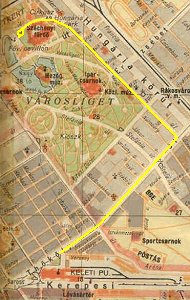 After
World War II route 44 was detoured to Bosnyák tér (and later
to the Rákospatak loop which is not used anymore, but can still
be seen). Route 25 was first cut back to Keleti pályaudvar, then
(in 1955) extended to Nagyvárad tér over Fiumei út and
Orczy út, and then cut back again to Keleti. In 1959
it was re-extended to Nagyvárad tér, another year later it was
re-cut to Keleti. Talking about a turbulent life!
After
World War II route 44 was detoured to Bosnyák tér (and later
to the Rákospatak loop which is not used anymore, but can still
be seen). Route 25 was first cut back to Keleti pályaudvar, then
(in 1955) extended to Nagyvárad tér over Fiumei út and
Orczy út, and then cut back again to Keleti. In 1959
it was re-extended to Nagyvárad tér, another year later it was
re-cut to Keleti. Talking about a turbulent life!
 And
the loop beside the railway station was not the final destination for
this route: in 1967 the inner terminus was relocated to the crossing of
Hermina út and Thököly út. You can see this short route
25 on the map to the right. There was also an occasional service called
44Y which ran during exhibitions taking place at Hungexpo site in Városliget,
and special services used the points in Hermina út for reversing
during sport events taking place in and around Népstadion.
And
the loop beside the railway station was not the final destination for
this route: in 1967 the inner terminus was relocated to the crossing of
Hermina út and Thököly út. You can see this short route
25 on the map to the right. There was also an occasional service called
44Y which ran during exhibitions taking place at Hungexpo site in Városliget,
and special services used the points in Hermina út for reversing
during sport events taking place in and around Népstadion.
The early years of the seventies proved to be fatal for the trams here: first Hungexpo moved to Kőbánya, so there was no call for the line's extra capabilites, and then the Milleneum Underground Line was extended to Mexikói út, with the surface section being hacked away. Because of the construction works for the new tunnel of the underground, tram traffic was supplemented with buses from 1. November, 1972. One year later the tram line was officialy closed. A supplementary bus service ran until 1977. The trolleybus line 72 rides most of the last route of this tram line nowadays.
At the corner of Hermina út and Thököly út you can still make out the place of the rails in the cobbles.
UZ "aluminium tram" (a UV built (mostly) out of aluminium and the electric circuits of the 3600-series) at the last terminus of the line. This is where now the terminus of trolleybus line 72 is.
The overhead wire supports are still there because of the trolleybus line. You can also see some other reminiscences like this metal thing that held the tram stop sign once.
The crossing of Hermina út and Ajtósi Dürer sor with tramcar number 1525 and Trabants (strange automobiles manufactured in East-Germany, which were typical for socialist countries in Eastern Europe - people waited years until being permitted to buy one of these, so please don't laugh!).
This is where the tracks went down from the middle of the street to the side, where they had their own right of way. Some of the overhead supports seen here belonged to the tram once. This is also the place where the tracks turned onto Ajtósi Dürer sor before 1941, just like we saw on this picture.
The stop at the corner from the other side.
To the left: UV on the tracks in Hermina út. To the right: you cannot get the same sight because of the new building of the Transport Museum that has been built here in the eighties :-)
Next page: from Hermina út to the loop terminus at the Zoo
Back to the top Back to the main page
